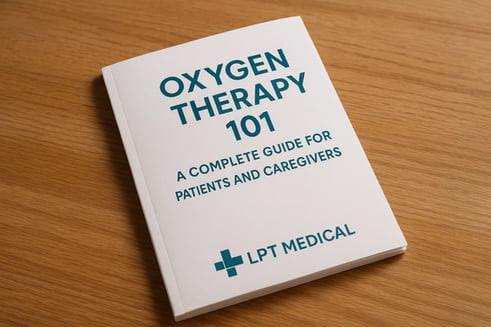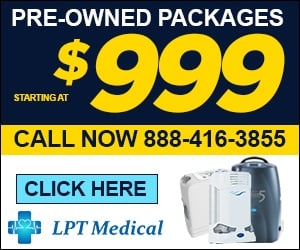
If you've been prescribed oxygen therapy, you're not alone. At LPT Medical, we work closely with individuals who are new to oxygen therapy and require guidance on how it works, what equipment is needed, and how to adjust to daily life without compromising their independence.
Whether you’re managing a chronic lung condition or helping a loved one, understanding oxygen therapy is essential. This guide provides a concise overview of what you need to know to get started.
What Is Oxygen Therapy?
Oxygen therapy is a treatment that helps individuals who cannot obtain sufficient oxygen on their own. It involves using a medical device to deliver supplemental oxygen through a nasal cannula or mask.
Why is this necessary? Oxygen is essential to every cell in your body. When your lungs can’t provide enough, it affects your energy, focus, sleep, and even your organs.
Common Conditions That May Require Oxygen:
- Chronic Obstructive Pulmonary Disease (COPD)
- Pulmonary fibrosis
- Emphysema
- COVID-19 aftereffects
- Sleep apnea (when used alongside CPAP)
- Heart failure
- Cystic fibrosis
- Severe asthma or pneumonia
Your doctor may recommend oxygen therapy if your blood oxygen levels consistently fall below normal (usually below 88% on a pulse oximeter).
How Does Oxygen Therapy Work?
Oxygen is delivered to your lungs through medical equipment, most commonly via a nasal cannula, which sits gently in the nostrils, or a face mask that covers the mouth and nose.
There are several ways to supply oxygen:
- Oxygen concentrators (stationary or portable)
- Compressed gas tanks
- Liquid oxygen systems
At LPT Medical, we focus on portable oxygen concentrators (POCs). These are lightweight, battery-powered devices that help you stay active while getting the oxygen you need.
Stationary vs. Portable Oxygen Options
Knowing your equipment options helps you find the right oxygen therapy to fit your lifestyle.
Stationary Oxygen Concentrators
These plug into a wall outlet and are ideal for use at home. They’re powerful and reliable, but not designed for travel or mobility.
Compressed Gas Cylinders
These metal tanks store oxygen under pressure. They don’t require electricity but are heavy and need regular refilling.
Liquid Oxygen Systems
These store oxygen in liquid form, allowing for higher capacity in smaller tanks. However, they’re more expensive and require a delivery system for refills.
Portable Oxygen Concentrators
(POCs)
POCs take in air, filter it, and provide concentrated oxygen when you need it. They are lightweight, rechargeable, FAA-approved, and give you more independence. LPT Medical offers top brands like ARYA, Inogen, CAIRE, and many more to fit different needs.
Who Needs Oxygen Therapy?
Your doctor will evaluate your need for oxygen based on:
- Pulse oximetry (SpO₂ measurement)
- Arterial blood gas (ABG) tests
- Symptoms like shortness of breath, fatigue, or confusion
You might need oxygen:
- 24/7 (continuous use)
- Only during sleep
- Only during physical activity
- At high altitudes or during travel
Your prescribed flow rate (the amount of oxygen you receive, in liters per minute or pulse dose) will determine the appropriate equipment.
Benefits of Oxygen Therapy
Used correctly, oxygen therapy can greatly improve the quality of life.
Benefits Include:
- Reduced shortness of breath
- Increased energy and endurance
- Better sleep and reduced nighttime oxygen dips
- Improved cognitive function
- Reduced heart strain
- Less anxiety during activity
Most people say that once they get used to oxygen therapy, they feel more like themselves again. They can enjoy walks, spend time with others, and sleep better.
Oxygen Therapy Safety at Home
Oxygen increases fire risk, so follow these basic guidelines.
Home Safety Tips:
- Never smoke near oxygen.
- Keep oxygen equipment away from open flames (candles, stoves, fireplaces).
- Do not use petroleum-based products like Vaseline near your nose or face.
- Store tanks upright and secure in well-ventilated areas.
- Check cords and tubing to prevent tripping hazards.
At LPT Medical, we help every customer set up and use their equipment safely, and we are always here to answer questions or help with any issues. The main point: following safety guidelines keeps you safe and gives you peace of mind at home.
Traveling with Oxygen Therapy
Modern portable concentrators allow most people to travel easily with oxygen therapy.
Travel Tips:
- Use an FAA-approved POC for air travel (like the ARYA Airtivo Max).
- Call your airline in advance to understand their oxygen policies.
- Bring extra batteries for longer trips.
- Pack a copy of your prescription and emergency contact information.
- Consider using a car charger or backup power for road trips.
- Use an air quality tracker to get real-time data.
Whether you are running a quick errand or flying across the country, planning helps you travel safely and with less stress, especially when using oxygen. The main idea: with good planning, you can travel comfortably with oxygen.
How to Care for Your Equipment
Your oxygen device requires regular cleaning and maintenance for safe and effective therapy.
Maintenance Checklist:
- Clean your nasal cannula or mask at least once a week (or as directed).
- Replace tubing monthly or when it shows signs of wear.
- Wipe your POC unit with a dry cloth and make sure no moisture gets inside the device.
- Clean or replace air filters according to the manufacturer's instructions.
- Charge batteries regularly and store extras properly.
If your unit starts to beep, flash warning lights, or experience a decline in performance, contact your supplier for service. At LPT Medical, we offer lifetime customer support for all oxygen concentrators we sell.
Busting Common Oxygen Myths
Many misunderstandings exist about oxygen therapy. Let’s clear them up.
Myth #1: "Oxygen is addictive."
Truth: Your body uses oxygen to function. If your doctor says you need it, you’re not becoming “addicted”—you’re compensating for a medical condition.
Myth #2: "Oxygen tanks are better than concentrators."
Truth: Concentrators don’t require refills and offer greater mobility. While tanks have their place, POCs are better suited for active lifestyles.
Myth #3: "You can’t go out in public with oxygen."
Truth: POCs are quiet, sleek, and discreet. Many users report increased confidence and independence with the right setup.
Choosing the Right Equipment with LPT Medical
Choosing an oxygen system can feel overwhelming. We’re here to help, from selection to support.
- Help choosing the right POC (Portable Oxygen Concentrator) based on your prescription
- Access to top brands at competitive prices
- Free resources and education for ongoing care
- Lifetime phone support and troubleshooting
- Financing and shipping options to fit your needs
We do more than sell machines. We help people breathe easier and live better lives.
Final Thoughts
Oxygen therapy isn’t about limitations. It’s about giving your body what it needs to feel stronger, safer, and more capable in your daily life.
At LPT Medical, our mission is to provide not only the best portable oxygen equipment but also the education, support, and care to help you or your loved one feel confident every step of the way.
Ready to find the best oxygen concentrator for your needs? Our team can help you choose the right solution. Call us at 800-946-1201
Contact us now at www.lptmedical.com or call to speak with an oxygen specialist for your free, personalized consultation today.


.png)



